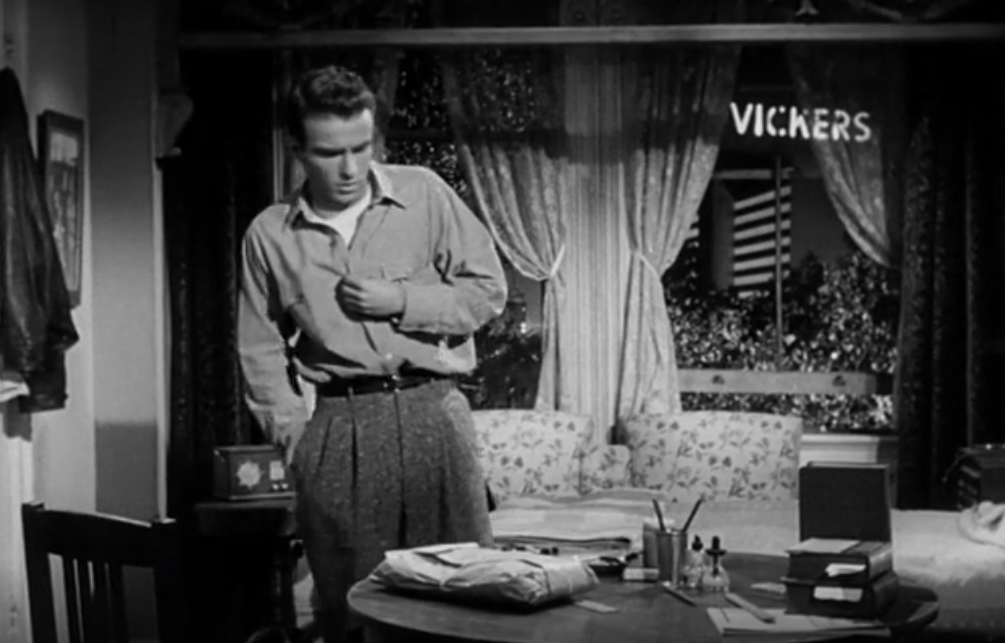Every month one of us makes the rest of the crew watch a movie they’ve never seen before, and we discuss it afterwards. This month Britnee made Boomer, Brandon, and Alli watch Peyton Place (1957).
Britnee: I love drama. Soap operas like The Bold and the Beautiful and Days of Our Lives were the inspiration for “playing pretend” with my Barbie dolls when I was a wee one. Now, as a grown adult, I spend most of my time in the BravoSphere obsessing over everything Real Housewives (when I’m not watching movies, of course). Yes, I like my drama on the trashy side, so it’s no surprise that I fell in love with the classic melodrama Peyton Place.
Peyton Place is adapted from Grace Metalious’s debut novel of the same name that shocked the world in 1956. It was regarded as smut by the public and banned in various cities and countries due to its racy subjects, including incest, rape, abortion, and adultery. Film producer Jerry Wald jumped on getting the rights to Peyton Place from Metalious less than a month after the novel was released. The result is definitely a sanitized version of the novel, but it’s still pretty scandalous considering that the film was released in 1957.
In the small New England town of Peyton Place, the gossip is hot and the secrets are plentiful. Michael Rossi (Lee Phillips) arrives for his new job as the high school principal along with his “liberal” education methods in tow. We soon find out that he is taking the position from Mrs. Thornton (Mildred Dunnock), who is a tenured English teacher more than fit for the job. There’s a plethora of sad moments throughout the film, but Mrs. Thornton’s heartbreak at that disappointment hits me so hard. We are then introduced to multiple families who have all sorts of juicy secrets, particularly the MacKenzies and the Crosses. Constance MacKenzie (Lana Turner) is a widow and shop owner, raising her only-child, Allison (Diane Varsi). Allison is best friends with Selena Cross (Hope Lange), who’s mother Nellie (Betty Fields), is Constance’s maid. Selena has an extremely rough life, especially compared to Allison’s. She lives in a shack with her mother, younger brother, and horrible alcoholic stepfather.
The judgmental and hypocritical society of Peyton Place causes irreparable damage to much of the community, particularly the youth. Allison is judged harshly by Constance for an innocent kiss, only to find out that she was the product of an affair. Selena is raped and impregnated by her stepfather, struggles to get an abortion, and miscarries due to an accident. Her mother, Nellie, then commits suicide at the MacKenzie residence. To make matters worse, she murders her stepfather in self-defense when he tries to attack her again and is put on trial. And that’s not even getting into Rodney & Betty’s struggles outside the main drama. There is never a dull moment in the film, since we are following so many different families and couples, which is one of the things I appreciate most about it. You can rewatch it multiple times and focus on a different character each time. It’s movie magic!
I’m dying to know what the rest of the crew thought of this movie. We’re there any characters y’all found more fascinating than others?
Brandon: I loved this. It’s the exact intersection of high and low art sensibilities where you’ll find most of cinema’s shiniest gems. For whatever reputation Peyton Place might have as a trashy paperback, this adaptation treats it with the same wide Cinemascope vistas and sweeping orchestral overtures you’d expect in a David Lean adaptation of a literary classic. A sprawling, gossipy epic of small-town scandal & melodrama, it’s essentially Douglas Sirk’s “Harper Valley PTA”, an exquisite rendering of sensationalist pulp. The material at hand earns that treatment too. No matter what prurient curiosity the novel may have held as the Fifty Shades of Grey of its time, it also functions as politically-minded sex education advocacy. It argues that good, healthy sex habits should be openly discussed and even taught in schools, since the small-town sex shaming of all “dirty talk” is what causes heartbreak & tragedy in these doomed characters’ lives. There’s something genuinely radical about its 50s-era sex positivity, especially when the proudly horny Allison explains to her male classmate “Girls want to do the same things as boys,” a truth that still hasn’t been fully absorbed in small-town American rhetoric.
Singling out individual characters is a smart way to discuss this film, since there are seemingly hundreds to choose from, each representing their own hot-button issue meant to inspire hushed watercooler & beauty salon chatter among anyone lucky enough to have visited Peyton Place. I was also heartbroken by the professional disappointments Mrs. Thornton suffers in the first act; I found myself crying over her open-hearted kindness within seconds of meeting her, as her students pooled money together to buy a congratulatory gift for a promotion that never came. She’s only a small part of the story, though, especially as her potentially pompous replacement proves himself to be just as noble & progressive in his approach to teen-years education. What I was more hanging on the edge of my seat about was the character arc of Allison’s friend Norman Page (Russ Tamblyn).
Throughout the film, Norman is portrayed as sexually timid & confused, to the point where he was an obvious representative of closeted (and maybe even oblivious) homosexuality. What was unclear was how far the movie could possibly go in openly discussing his sexual orientation, beyond broad, Freudian characterizations of his overbearing mother and his self-hating nature as a “coward” and a “sissy.” My fear was that Allison would be romantically paired with Norman as a narrative attempt to “cure” him, but thankfully they just remain good friends & co-conspirators. Like many of the hot-button issues the movie collects like Pokémon, Norman’s status as a sexual outlier is never exactly challenged or resolved. It’s more just plainly represented as a simple fact of life (as much as it could be in a time of intense sexual repression). The difference with Norman’s sexual identity crisis, though, is that it’s never openly discussed like the affairs, suicides, rapes, and miscarriages playing out elsewhere in town. Even for a movie that proudly tackles the most sensational topics of its day, Norman’s (ambiguous, unconfirmed) queerness is too controversial to be discussed in clear, honest terms, which is what makes him such a fascinating character to keep track of in the larger crowd. There’s a tension to seeing just how far the movie is willing to go in his characterization in every scene he enters.
Boomer: It’s funny that Brandon should mention “Harper Valley PTA,” since that’s the only real exposure that I had to Peyton Place (other than its use as exactly the same epithet that Jeannie C. Riley used) prior to this viewing: “You think that as the mother I’m not fit / Well, this is just a little Peyton Place / And you’re all Harper Valley hypocrites.” That is to say, a Peyton Place is somewhere that there’s an awful lot of funny business going on, if you know what I mean. I don’t know how much of that was born out of the film itself and how much was the result of the various sequel soaps and other adaptations that were released in its wake, because in practice, there’s actually very little sex in the film, with what little there is being unspoken or deep in the back story, while the forefront is composed of so much suspicion and gossip. There’s one really frisky classmate of Allison and Selena who flirts with the former before devoting himself to his one real childhood sweetheart (to whom he seems faithful despite his raging hormones, especially in combination with his disdain for his father’s own implied adulteries), and then in the backstory Connie had an affair with a married man, of which Allison is the product. It’s barely salacious, even for the time period, and only the first of these is common knowledge, though it enters the town’s thriving marketplace of gossip attached to the incorrect players. Peyton Place’s prosperity comes in the form of its textile mill, but it runs just as much on the rumor mill, as very little information that gets passed around is accurate, and real secrets get covered over in the rush. Connie’s affair could have remained hidden forever, just like Lucas Cross’s crimes and sins, because town gossip was mostly concerned with fiction.
I, like Brandon, also thought of Douglas Sirk while watching this, but in my mind I titled it “Sirk’s Twin Peaks” because in both titular towns, the deepest and most harrowing crime is at the expense of a teenage girl and mostly concerns itself with her peers and the people of her parents’ generation who are supposed to be looking out for their children. (And they both have Russ Tamblyn!) It could just as easily have been Sirk’s Blue Velvet, however, given that it was the earlier of David Lynch’s works about an idyllic town with a monstrous underbelly of violent unchained id and a facade of perfect Americana with a maggoty core. (And they both have Hope Lange!) But the film is only Lynchian in its topic, not in its tone or its temperament, and in this mixture between the cheerful color of full-on Cinemascope melodrama and its seedy story of suspicion and vice that makes it feel at once both dated and timeless in the best possible way.
Alli: I went into this movie, as I do with a lot of movies from this era, with my 1950s housewife lenses on. I like to imagine that I’m completely fresh and contemporary to an old movie. From that perspective, Peyton Place is positively lurid. Teenage sexuality? Class consciousness? Education reforms? Abortion? Absolutely shocking. Which is why I couldn’t stay in that frame of mind for long. It’s just too ahead of its time. I’m honestly astonished that it even got made. It’s not always an easy watch, but it is a worthwhile one, filled with drama, critiques of small town America, and necking. If this movie were made on this scale today, there are still people who would find it absolutely shocking and controversial.
It starts off strong with Michael Rossi arriving in town observing the dilapidated shacks on the wrong side of the tracks, only to arrive on mainstreet in this idyllic New England hamlet, complete with beautiful green trees, gorgeous homes, and quaint local businesses. He has a conversation with a restaurant owner about the state of employment in Peyton Place where we find out that almost everyone works at a woolen mill and that business has a stranglehold over everything in town. Like any town where one industry dominates the entire economy, the business owners have a vested interest in making sure that education is undervalued and that the status quo is maintained. Rossi does manage to haggle for a better salary, even with the reluctance of the school board, probably because he is not the “older” woman Mrs. Thorton (“older” in scare quotes here because it’s later revealed that she’s in her mid to late 40s). This clash of capitalistic American values against an educator’s desire for fairness and equality for all students is riveting. When he’s demanding a salary and refusing to do the unpaid labor of coaching sports teams, I was elated. We need more movies where characters stick up for themselves in the faces of tycoons.
All these teens’ stories are so good. I love them sneaking around and indulging in horny teenage rebellion. I love Betty slutting it up. It’s extremely satisfying when Allison stands up for herself to her hypocrite mother. Norman suffering his Psycho-esque Norma Bates mother is just oedipal perfection. Selena’s story, however, is heartbreaking, and quite frankly, it was extremely difficult for me to watch. The abuse she suffers at the hands of her stepfather is presented so starkly and realistically. In a movie full of overblown drama, this plot line unfortunately feels the most realistic until the town rallies behind her (real life is rarely that hopeful). When she snaps and kills Lucas, it is weirdly satisfying, even with the thought that she may have just doomed herself by trying to save herself.
I’m so glad that I watched this soapy, melodramatic epic. It is going to stick in my mind for a long time.
Lagniappe
Alli: I was so focused on how great the narrative is, I forgot to mention it’s beautiful too! How about Mrs. Mackenzie in that red dress going to Rossis’ house for Christmas? The bright, saturated colors there are just wonderful.
Brandon: My only previous exposure to Peyton Place was the shot of Jayne Mansfield reading it during a self-indulgent bubble bath in Will Success Spoil Rock Hunter?, a visual gag that’s much funnier now that I know of the novel’s sub-literary reputation.
Britnee: I find myself referencing Peyton Place more and more as I get older. I’m not sure if that’s a good thing, but it’s a reminder of how relevant the film still is. It should come as no surprise that a Peyton Place themed excursion to its Camden, Maine filming location is on my vacation wishlist. The Camden Public Library even put together a map of Peyton Place landmarks. The majority of the locations haven’t changed much since 1957. It’s the melodramatic time capsule of my dreams!
Boomer: I was on the edge of my seat waiting to see which actor I knew from their appearances on Alfred Hitchcock Presents or The Alfred Hitchcock Hour would appear next. I immediately recognized Mildred Dunnock (Mrs. Thornton) from her three appearances in the former program and her singular appearance in the latter, in the episodes “None Are So Blind,” “The West Warlock Time Capsule,” “Heart of Gold,” and “Beyond the Sea of Death.” Arthur Kennedy (Lucas Cross) appeared in the Hour episode “Change of Address,” Betty Field (Nellie Cross) was in the Presents episode “A Very Moral Theft” and “The Star Juror” episode of Hour, and Staats Cotsworth (Charles Partridge) had a role in Hour‘s “The Thirty-First of February.” Even Lorne Green, who will forever be the original Battlestar Galactica‘s Commander Adama to me, appeared in the Presents episode “Help Wanted.” Surprisingly, the big one was Robert H. Harris, who played Peyton Times editor Seth Bushwell: the was in no fewer than eight episodes of Presents (“Shopping for Death,” “The Orderly World of Mr. Appleby,” “The Hidden Thing,” “Toby,” “The Dangerous People,” “The Safe Place,” :Graduating Class,” and “The Greatest Monster of them All”) and an episode of Hour entitled “Consider Her Ways.”
Next month: Brandon presents Will Success Spoil Rock Hunter? (1957)
-The Swampflix Crew


















